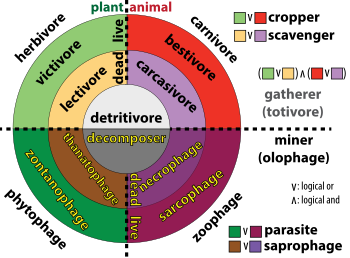Consumer–resource interactions
Consumer–resource interactions are the core motif of ecological
Classification of consumer types
The standard categorization
Various terms have arisen to define consumers by what they eat, such as meat-eating
The Getz categorization

Another way of categorizing consumers, proposed by South African American ecologist Wayne Getz, is based on a biomass transformation web (BTW) formulation that organizes resources into five components: live and dead animal, live and dead plant, and particulate (i.e. broken down plant and animal) matter.[4] It also distinguishes between consumers that gather their resources by moving across landscapes from those that mine their resources by becoming sessile once they have located a stock of resources large enough for them to feed on during completion of a full life history stage.
In Getz's scheme, words for miners are of Greek etymology and words for gatherers are of Latin etymology. Thus a bestivore, such as a cat, preys on live animals (Latin: bestia=animal) while a sarcophage, such as a
Specialist totivores (gatherers)
- Folivore
- Frugivore
- Fungivore
- Carnivore
- Insectivore
- Molluscivore
- Piscivore
- Avivore
- Spongivore
- Graminivore
- Granivore
- Nectarivore
- Palynivore
- Bacterivore
- Detritivore
- Ophiophagy
Specialist olophages (miners)
- Coprophagy
- Geophagy
- Hematophagy
- Lepidophagy
- Mucophagy
- Myrmecophagy
- Osteophagy
- Oophagy
- Ophiophagy
- Ovophagy
- Placentophagy
- Saprophagy
- Sarcophagy
- Thanatophagy
- Xylophagy
- Zontanophagy
See also
- Cannibalism
- Food web
- Herbivore
- Omnivore
- Parasitoid
- Predation
- Scavenger
- Trophallaxis
- Consumer-resource model
References
- S2CID 2249052.
- ISBN 9781400847259.
- ISBN 9781400847280.
- ^ PMID 21199247.
